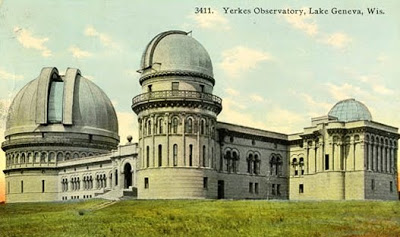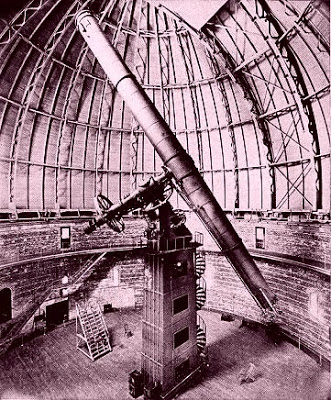Philosophy


Okay, "bigger is better"--sort of. And what's the connection with Otto Struve [II]. 150 years ago or so telescopes, the refractor type, were the "thing". Now, in 1847 the Harvard College Observatory had two 15" refracting telescopes...one of which was appropriated by Friedrich Struve [founder and director of the Pulkovo Observatory, just south of St. Petersburg and Otto[II]'s grandfather]. But the rush was on and soon the University of Chicago had an 18" refractor and the US Naval Observatory had a 26" refractor. Still think "bigger sis better"? Maybe. So Otto Struve [I], who had become Puklovo's Director in 1862, travelled to the United States to talk to the best telescope makers...Alvin Clark & Sons. A deal was struck for a 30" refractor and the goods were delivered at the Polkovo Observatory in 1885. We are getting bigger. But three years later for the Lick Observatory in California installed a 36" refractor and they held the title until 1897 when the Yerkes Observatory in Wisconsin put in a 40" refractor. Well, that was the limit on the "bigger is better" notion, for telescope designers were beginning to design better telescopes, the reflector type, based on Newton's invention. These telescopes didn't have to be "big" to be better for they relied on a totally different observing methodology...concentrating light on a mirrored surface and then reflected to an eye piece....no more color issues or distortions. The Pulkovo Observatory's 30" refractor continued to function until World War II when the German army shelled the Pulkovo Observatory into rubble. The 30" lens was saved, but the telescope itself is gone. Struve's grandson, Otto Struve [II] was exiled from Russia during the Civil War of 1919, and he fled to the United States. It is ironic that he rose to become director of the Yerkes Observatory, whose 40" refractor does survive, and is still the largest operable refractor in the world.
Otto Wilhelm von Struve [I] [son of Friedrich Georg Wilhelm von Struve] [May 7th, 1819 to April 14th, 1905] had two sons: Hermann Struve [October 3rd, 1854 to August 12th, 1920] and Ludwig Struve [November 1st, 1858 to November 4th, 1920] who was the father of Otto Struve [II] [August 12th, 1897 to April 6th, 1963].
[NOTE: The notation "I" and "II" are not part of their names. I used them to differentiate between them.]
- Van Vleck Observatory...100 Years Old
"Many Moons Ago: Scoping out the Astronomy Department’s History" by Rebecca Brill February 6th, 2014 The Wesleyan Argus This year marks the 100th anniversary of the construction of the esteemed Van Vleck Observatory, though the Astronomy Department...
- Birthplace Of American Astronomy...the Cincinnati Observatory
"How Cincinnati became the "Birthplace of American Astronomy."" by Ann Thompson April 12th, 2013 WVXU The Cincinnati Observatory is celebrating an anniversary this weekend. It was 168 years ago that a prominent Cincinnatian made the city the "Birthplace...
- Étienne Léopold Trouvelot And Some Fantastic Lithographs
Bill Ashworth [UMKC Philosophy Department] wrote in his newsletter... Etienne Trouvelot, a French artist turned American astronomer, died Apr. 22, 1895. Trouvelot came to the U.S. in 1850 and moved to Boston, where he was employed as a nature artist...
- Things Disappear
Amazing how some are stored in the memory or photographs long after the actual item is gone and one often wonders what happened to that object. Near me is Park University and had high on top of a hill an observatory that had been designated as the oldest...
- Vatican Astronomy
The Vatican has other interests too--astronomy and a rare book collection. Castel Gandolfo Italy Zeiss Double Astrograph Schmidt Telescope And in conjunction with the Mount Graham International Observatory in southeastern Arizona forming the Vatican...
Philosophy
Yerkes Observatory...40 incher...Otto Struve [II]


Okay, "bigger is better"--sort of. And what's the connection with Otto Struve [II]. 150 years ago or so telescopes, the refractor type, were the "thing". Now, in 1847 the Harvard College Observatory had two 15" refracting telescopes...one of which was appropriated by Friedrich Struve [founder and director of the Pulkovo Observatory, just south of St. Petersburg and Otto[II]'s grandfather]. But the rush was on and soon the University of Chicago had an 18" refractor and the US Naval Observatory had a 26" refractor. Still think "bigger sis better"? Maybe. So Otto Struve [I], who had become Puklovo's Director in 1862, travelled to the United States to talk to the best telescope makers...Alvin Clark & Sons. A deal was struck for a 30" refractor and the goods were delivered at the Polkovo Observatory in 1885. We are getting bigger. But three years later for the Lick Observatory in California installed a 36" refractor and they held the title until 1897 when the Yerkes Observatory in Wisconsin put in a 40" refractor. Well, that was the limit on the "bigger is better" notion, for telescope designers were beginning to design better telescopes, the reflector type, based on Newton's invention. These telescopes didn't have to be "big" to be better for they relied on a totally different observing methodology...concentrating light on a mirrored surface and then reflected to an eye piece....no more color issues or distortions. The Pulkovo Observatory's 30" refractor continued to function until World War II when the German army shelled the Pulkovo Observatory into rubble. The 30" lens was saved, but the telescope itself is gone. Struve's grandson, Otto Struve [II] was exiled from Russia during the Civil War of 1919, and he fled to the United States. It is ironic that he rose to become director of the Yerkes Observatory, whose 40" refractor does survive, and is still the largest operable refractor in the world.
Otto Wilhelm von Struve [I] [son of Friedrich Georg Wilhelm von Struve] [May 7th, 1819 to April 14th, 1905] had two sons: Hermann Struve [October 3rd, 1854 to August 12th, 1920] and Ludwig Struve [November 1st, 1858 to November 4th, 1920] who was the father of Otto Struve [II] [August 12th, 1897 to April 6th, 1963].
[NOTE: The notation "I" and "II" are not part of their names. I used them to differentiate between them.]
- Van Vleck Observatory...100 Years Old
"Many Moons Ago: Scoping out the Astronomy Department’s History" by Rebecca Brill February 6th, 2014 The Wesleyan Argus This year marks the 100th anniversary of the construction of the esteemed Van Vleck Observatory, though the Astronomy Department...
- Birthplace Of American Astronomy...the Cincinnati Observatory
"How Cincinnati became the "Birthplace of American Astronomy."" by Ann Thompson April 12th, 2013 WVXU The Cincinnati Observatory is celebrating an anniversary this weekend. It was 168 years ago that a prominent Cincinnatian made the city the "Birthplace...
- Étienne Léopold Trouvelot And Some Fantastic Lithographs
Bill Ashworth [UMKC Philosophy Department] wrote in his newsletter... Etienne Trouvelot, a French artist turned American astronomer, died Apr. 22, 1895. Trouvelot came to the U.S. in 1850 and moved to Boston, where he was employed as a nature artist...
- Things Disappear
Amazing how some are stored in the memory or photographs long after the actual item is gone and one often wonders what happened to that object. Near me is Park University and had high on top of a hill an observatory that had been designated as the oldest...
- Vatican Astronomy
The Vatican has other interests too--astronomy and a rare book collection. Castel Gandolfo Italy Zeiss Double Astrograph Schmidt Telescope And in conjunction with the Mount Graham International Observatory in southeastern Arizona forming the Vatican...
